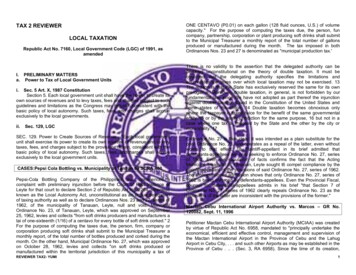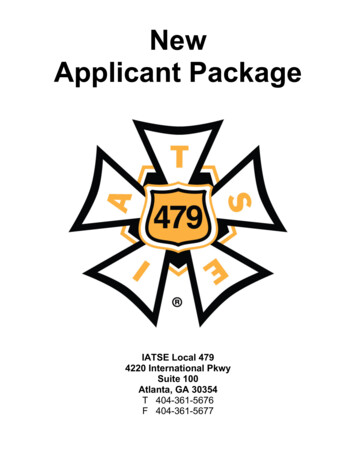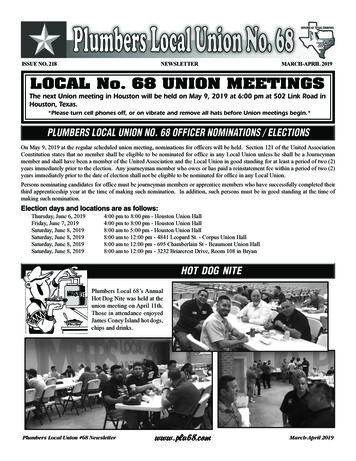
Transcription
From Local to Global in Number TheorySamit DasguptaDuke UniversityJune 21, 2019
Local and Globallocal: 1: characterized by or relating to position in space: having adefinite spatial form or location2(a): of, relating to, or characteristic of a particular place: notgeneral or widespread(b): of, relating to, or applicable to part of a whole
Local and Globallocal: 1: characterized by or relating to position in space: having adefinite spatial form or location2(a): of, relating to, or characteristic of a particular place: notgeneral or widespread(b): of, relating to, or applicable to part of a whole
Local and Globalglobal: 1(a): of, relating to, or involving the entire world.(b): of or relating to a spherical celestial body (such as the moon)2: of, relating to, or applying to a whole (such as a mathematicalfunction or a computer program)
Example: Ants on a circleClick here for animation of zooming in on a circle
Ants on a circleThis is a failure of drawing global inferences from local data.Every ant thinks the circle is “flat.” Even if you talk to all the antsat the same time, you can’t figure out the global information thatthe circle loops back to itself.The ants can’t tell the difference between a straight line and acircle.
Ants on a circleThis is a failure of drawing global inferences from local data.Every ant thinks the circle is “flat.” Even if you talk to all the antsat the same time, you can’t figure out the global information thatthe circle loops back to itself.The ants can’t tell the difference between a straight line and acircle.
Ants on a circleThis is a failure of drawing global inferences from local data.Every ant thinks the circle is “flat.” Even if you talk to all the antsat the same time, you can’t figure out the global information thatthe circle loops back to itself.The ants can’t tell the difference between a straight line and acircle.
Number TheoryBroadly speaking, number theory is motivated by two types ofquestions:1What is the distribution of primes? (e.g. are there infinitelymany? how many are there less than 1,000,000? Are thereinfinitely many twin primes?)2What are the integer solutions to polynomial equations? (e.g.x 2 y 2 z 2 , x n y n z n ).
Number TheoryBroadly speaking, number theory is motivated by two types ofquestions:1What is the distribution of primes? (e.g. are there infinitelymany? how many are there less than 1,000,000? Are thereinfinitely many twin primes?)2What are the integer solutions to polynomial equations? (e.g.x 2 y 2 z 2 , x n y n z n ).
Number TheoryBroadly speaking, number theory is motivated by two types ofquestions:1What is the distribution of primes? (e.g. are there infinitelymany? how many are there less than 1,000,000? Are thereinfinitely many twin primes?)2What are the integer solutions to polynomial equations? (e.g.x 2 y 2 z 2 , x n y n z n ).
Real solutionsReal solutions are “easier.” Pythagorean eqn: x 2 y 2 z 2
Integer solutionsBut number theorists are interested in the integer (or rational)solutions to equations.Integers Z, Rationals Q32 42 5252 122 13292 402 412.
First Question — Are there any integer solutions?Consider the equation x 2 y 2 4 0.There are no real solutions, since the left side is always positive, sothere are no integer solutions.
First Question — Are there any integer solutions?Consider the equation x 2 y 2 4 0.There are no real solutions, since the left side is always positive, sothere are no integer solutions.
First Question — Are there any integer solutions?Consider the equation x 2 x 2y 1.There are no integer solutions since the left side is always even,and the right side is always odd.
First Question — Are there any integer solutions?Consider the equation x 2 x 2y 1.There are no integer solutions since the left side is always even,and the right side is always odd.
Parity is x mod 2Asking whether a number is odd or even is asking:“When we divide the number by 2, is the remainder 0, or 1?”More generally, given a positive integer n, we can define x(mod n) to be the remainder when we divide x by n.
Parity is x mod 2Asking whether a number is odd or even is asking:“When we divide the number by 2, is the remainder 0, or 1?”More generally, given a positive integer n, we can define x(mod n) to be the remainder when we divide x by n.
Modular arithmeticWe define Z/n {0, 1, 2, . . . , n 1}, the set of possibleremainders when you divide by n.We can consider solutions to equations in Z/n.The equation y 2 x 3 2 has the solution (x, y ) (3, 2) in Z/5,since 22 29 4 (mod 5).
Modular arithmeticWe define Z/n {0, 1, 2, . . . , n 1}, the set of possibleremainders when you divide by n.We can consider solutions to equations in Z/n.The equation y 2 x 3 2 has the solution (x, y ) (3, 2) in Z/5,since 22 29 4 (mod 5).
Modular arithmeticWe define Z/n {0, 1, 2, . . . , n 1}, the set of possibleremainders when you divide by n.We can consider solutions to equations in Z/n.The equation y 2 x 3 2 has the solution (x, y ) (3, 2) in Z/5,since 22 29 4 (mod 5).
Another examplex3 x y2 1The left side is always 0 mod 3.The right side is always 1 or 2 mod 3.Since there are no solutions in Z/3, there are no solutions in Z.
Another examplez4 z2 1 x2 y2Left side is always 3 mod 4.Right side is always 0, 1, or 2 mod 4.Since there are no solutions in Z/4, there are no solutions in Z.
Local and Global in Number theoryGlobal means looking for solutions to an equation in Z or Q.Local means looking for solutions in R or mod p m for every primep and integer m 1.Local to Global principle: If a polynomial equation has solutionsin R and mod p m for all primes p and m 1, does it necessarilyhave solutions in Z?
Hasse’s principleA quadratic polynomial has solutions in Z if and only if it hassolutions in R and mod p m for every prime p and m 1.
Selmer’s famous exampleHowever, Hasse’s principle does not hold once we pass the realm ofquadratic polynomials.The equation 3x 3 4y 3 5z 3 0 has nontrivial solutions in R andmod p m for all primes p, m 1, but no nontrivial solutions in Z.
Selmer’s famous exampleHowever, Hasse’s principle does not hold once we pass the realm ofquadratic polynomials.The equation 3x 3 4y 3 5z 3 0 has nontrivial solutions in R andmod p m for all primes p, m 1, but no nontrivial solutions in Z.
When does a cubic equation have a rational solution?There is an algorithm, called descent, which can determine if agiven cubic equation has a solution.It is an open conjecture as to whether this algorithm alwaysterminates!Proving that this algorithm terminates is a huge open problem innumber theory.
When does a cubic equation have a rational solution?There is an algorithm, called descent, which can determine if agiven cubic equation has a solution.It is an open conjecture as to whether this algorithm alwaysterminates!Proving that this algorithm terminates is a huge open problem innumber theory.
When does a cubic equation have a rational solution?There is an algorithm, called descent, which can determine if agiven cubic equation has a solution.It is an open conjecture as to whether this algorithm alwaysterminates!Proving that this algorithm terminates is a huge open problem innumber theory.
Finding all solutions, if we know they existQuadratics: Pythagorean example, x 2 y 2 1.Start with the point ( 1, 0).Line with rational slope tthrough this point:y t(x 1).It must intersect circle atanother rational point.1 t 22t(x, y ) ( 1 t2 , 1 t 2 ).
Integer solutionsIf we write t m/n, and scale through the denominator, we get aparamaterization of all primitive integer solutions to x 2 y 2 z 2 :(x, y , z) (n2 m2 , 2mn, n2 m2 ).
Elliptic CurvesA (nonsingular) cubic equation in two variables with at least onerational solution is called an elliptic curve.After a change of variables, these can always be writteny 2 x 3 bx c.
Composition LawIf we start from a rationalpoint, and draw a line withrational slope, the other twopoints of intersection need notbe rational.But if we start with tworational points, then the thirdpoint has to be rational.
A simpler way to get a newrational point is to flip acrossthe x-axis.We can keep doing thisprocedure repeatedly—drawinglines between two points wehave, taking the third point ofintersection, and flipping.
Mordell’s TheoremAll the rational points on thecurve can be obtain from thisprocess starting with onlyfinitely many.The minimum number ofpoints you need, excluding the“torsion points”, is called therank r .
Studying the rankIntuitively, the bigger r is, the more rational points there are onthe curve.For a given curve, can we figure out r ?In the 1960s, Birch and Swinnerton-Dyer explored whether there isa local-to-global principle at work here.
Studying the rankIntuitively, the bigger r is, the more rational points there are onthe curve.For a given curve, can we figure out r ?In the 1960s, Birch and Swinnerton-Dyer explored whether there isa local-to-global principle at work here.
Studying the rankIntuitively, the bigger r is, the more rational points there are onthe curve.For a given curve, can we figure out r ?In the 1960s, Birch and Swinnerton-Dyer explored whether there isa local-to-global principle at work here.
Birch–Swinnerton-Dyer conjectureFor each prime p, let Np be the number of solutions to theequation of the curve mod p.For example, for y 2 x 3 1 and p 5, we have the points(0, 1), (0, 4), (2, 2), (2, 3), (4, 0), , so Np 6.Birch and Swinnerton–Dyer found thatY Nppp xgrew faster as a function of x, the larger r was.
Birch–Swinnerton-Dyer conjectureFor each prime p, let Np be the number of solutions to theequation of the curve mod p.For example, for y 2 x 3 1 and p 5, we have the points(0, 1), (0, 4), (2, 2), (2, 3), (4, 0), , so Np 6.Birch and Swinnerton–Dyer found thatY Nppp xgrew faster as a function of x, the larger r was.
Birch–Swinnerton-Dyer conjectureFor each prime p, let Np be the number of solutions to theequation of the curve mod p.For example, for y 2 x 3 1 and p 5, we have the points(0, 1), (0, 4), (2, 2), (2, 3), (4, 0), , so Np 6.Birch and Swinnerton–Dyer found thatY Nppp xgrew faster as a function of x, the larger r was.
Birch–Swinnerton-Dyer conjectureMore precisely, they conjecturedY Np C (log x)rpp xfor some non-zero constant C , where r is the rank of the curve.This is one of the most important unsolved problems in all ofmathematics.
Birch–Swinnerton-Dyer conjectureMore precisely, they conjecturedY Np C (log x)rpp xfor some non-zero constant C , where r is the rank of the curve.This is one of the most important unsolved problems in all ofmathematics.
The Unit equationConsider the equation:xy 1 0.Then Np number of solutions mod p is equal to p 1. Y NpY p 1Y 1 1 .pppp xp xp x
The Unit equationConsider the equation:xy 1 0.Then Np number of solutions mod p is equal to p 1. Y p 1Y Y Np1 1 .pppp xp xp x
Geometric SeriesLet’s consider the inverse of this:Yp x1.1 1/pUsing1 1 r r2 r3 · · · ,1 rwe get Y 1111 2 3 ··· .p ppp x
Geometric SeriesLet’s consider the inverse of this:Yp x1.1 1/pUsing1 1 r r2 r3 · · · ,1 rwe get Y 1111 2 3 ··· .p ppp x
Geometric SeriesLet’s consider the inverse of this:Yp x1.1 1/pUsing1 1 r r2 r3 · · · ,1 rwe get Y 1111 2 3 ··· .p ppp x
Unique Factorization 1111111 2 ···1 2 ··· 1 2 ···2 23 35 51 1 1 1 1 1 1 1 ··· 2 3 4 5 6 8 9the sum of 1/n for all n whose prime factors are 2, 3, 5.
In the limitIf we send x , then we get Yp primeX11 .1 1/pnn 1From this it follows there are infinitely many primes.(This was Euler’s proof.)
In the limitIf we send x , then we get Yp primeX11 .1 1/pnn 1From this it follows there are infinitely many primes.(This was Euler’s proof.)
Riemann Zeta FunctionRiemann realized that you should study, more generally, ζ(s) Yp primeX 11 1 1/p snsn 1where s is a complex number.That sum only converges for s with real part 1, but Riemannshowed how to define it for all s.
Riemann Zeta FunctionRiemann realized that you should study, more generally, ζ(s) Yp primeX 11 1 1/p snsn 1where s is a complex number.That sum only converges for s with real part 1, but Riemannshowed how to define it for all s.
Some special valuesζ(2) 1 1 11π2 ··· .4 9 166ζ(4) 1 111π4. ··· 24 34 4490ζ(2k) 1 111 2k 2k · · · Ck · π 2k ,22k34where Ck is a rational number related to Bernoulli Numbers.
The Riemann HypothesisConjecture. Other than ζ( 2k) 0 for k 0 an integer, we canonly have ζ(s) 0 if the real part of s is 1/2.
The Birch–Swinnerton-Dyer conjecture, revisitedTheorem (Hasse)For any elliptic curve E and any prime p, the integer ap p 1 Np satisfies ap 2 p.B-SD productY Nppp Y 1 ap ppp.Introduce s variable:L(E , s) 1Yp1 app s p 1 2sIntuitively,L(E , 1) Y Nppp! 1.
The Birch–Swinnerton-Dyer conjecture, revisitedTheorem (Hasse)For any elliptic curve E and any prime p, the integer ap p 1 Np satisfies ap 2 p.B-SD productY Nppp Y 1 ap ppp.Introduce s variable:L(E , s) 1Yp1 app s p 1 2sIntuitively,L(E , 1) Y Nppp! 1.
The Birch–Swinnerton-Dyer conjecture, revisitedTheorem (Hasse)For any elliptic curve E and any prime p, the integer ap p 1 Np satisfies ap 2 p.B-SD productY Nppp Y 1 ap ppp.Introduce s variable:L(E , s) 1Yp1 app s p 1 2sIntuitively,L(E , 1) Y Nppp! 1.
The Birch–Swinnerton-Dyer conjecture, revisitedTheorem (Hasse)For any elliptic curve E and any prime p, the integer ap p 1 Np satisfies ap 2 p.B-SD productY Nppp Y 1 ap ppp.Introduce s variable:L(E , s) 1Yp1 app s p 1 2sIntuitively,L(E , 1) Y Nppp! 1.
The Birch–Swinnerton-Dyer conjecture, revisitedConjectureE has infinitely many rational solutions (i.e. r 1) if and only ifL(E , 1) 0.More generally,ords 1 L(E , s) r .
Ants on a circle This is a failure of drawing global inferences from local data. Every ant thinks the circle is \ . number theory is motivated by two types of questions: 1 What is the distribution of primes? (e.g. are there in nitely . then the third point has to be rational.











